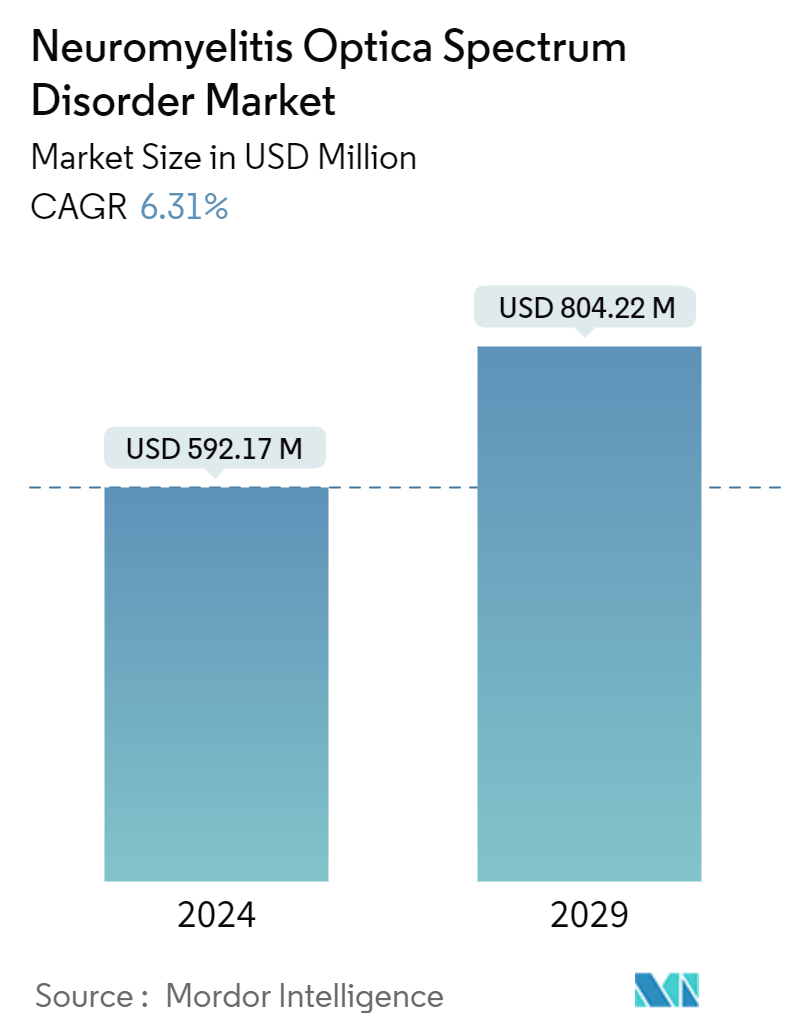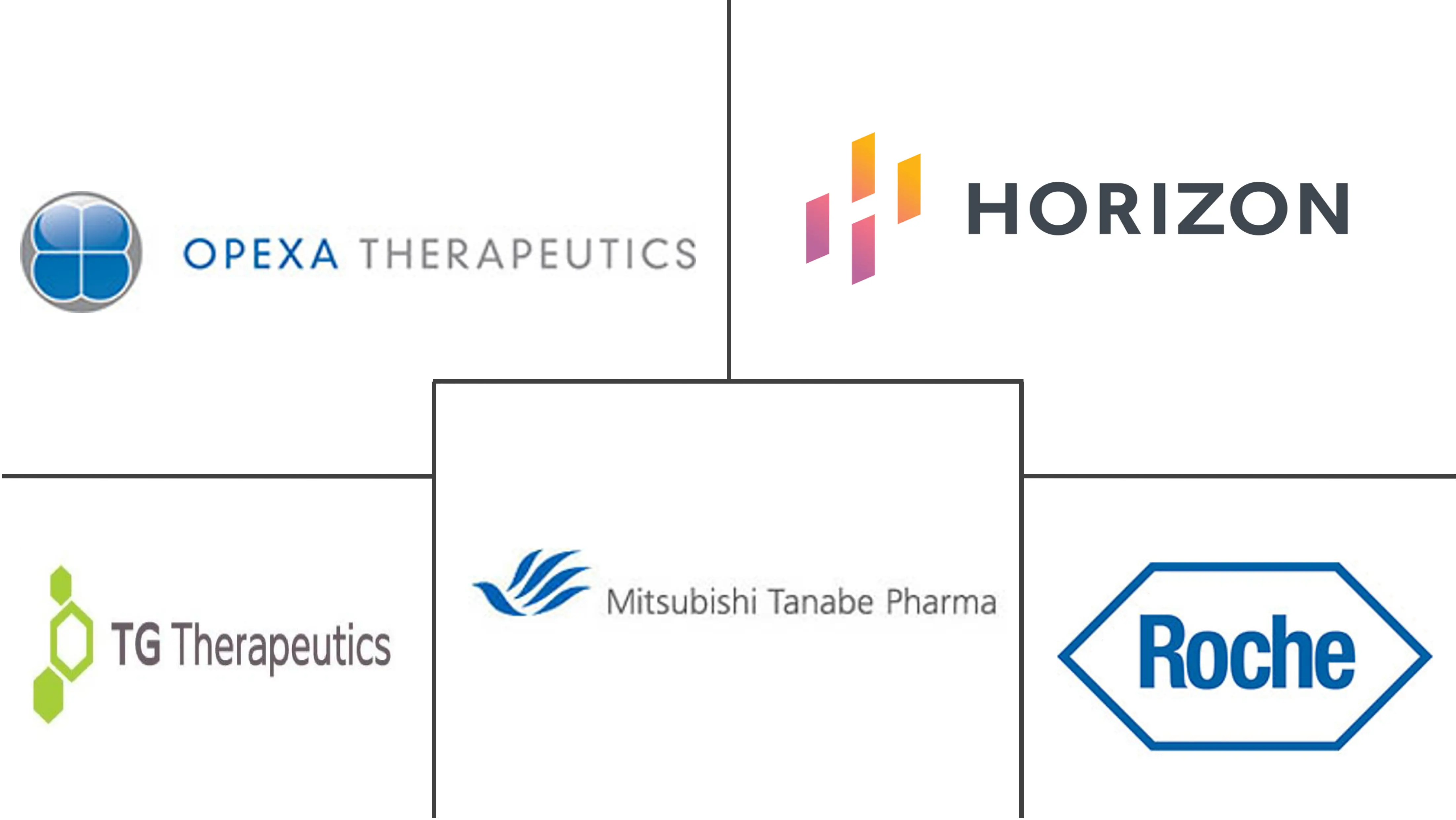Market Size of Neuromyelitis Optica Spectrum Disorder Industry

| Study Period | 2019 - 2029 |
| Market Size (2024) | USD 592.17 Million |
| Market Size (2029) | USD 804.22 Million |
| CAGR (2024 - 2029) | 6.31 % |
| Fastest Growing Market | Asia-Pacific |
| Largest Market | North America |
| Market Concentration | Medium |
Major Players
*Disclaimer: Major Players sorted in no particular order |
Neuromyelitis Optica Spectrum Disorder Market Analysis
The Neuromyelitis Optica Spectrum Disorder Market size is estimated at USD 592.17 million in 2024, and is expected to reach USD 804.22 million by 2029, growing at a CAGR of 6.31% during the forecast period (2024-2029).
The major factors driving the growth of the market for neuromyelitis optica spectrum disorder include the increasing incidence and prevalence of neuromyelitis optica spectrum disorder (NMOSD), rising demand for better treatment options, increasing research and development activities, and surging number of product approvals.
The rising prevalence of NMOSD worldwide is projected to drive the demand for immunosuppressive, monoclonal antibodies, and other drugs for its treatment, thereby driving market growth. For instance, according to an article published by the Neurological Sciences Journal in February 2023, the global prevalence and incidence rates of NMOSD ranged from 0.07 to 10 and 0.029 to 0.880 per 100,000 people, respectively.
According to an article published by StatPearls Journal in January 2024, NMOSD exhibited varying prevalence rates among demyelinating diseases worldwide. While it accounted for 1% to 2% in the United States and Italy, the figures soared to 13.7% in India and exceeded 30% in Thailand. As per the same source, NMOSD either relapsed, which occurs in 80% to 90% of cases, or was monophasic. The treatment often involves a brief stint of immunosuppressive therapy, commonly a corticosteroid, followed by a more prolonged regimen. Thus, the high prevalence of NMOSD and the high remission rate of the disease are projected to drive the demand for innovative drugs during the forecast period.
Various organizations are working toward providing funding support to researchers for the development of drugs to treat NMOSD. For instance, in July 2022, The Sumaira Foundation awarded research grants of up to USD 25,000 to nonprofit organizations, researchers, and institutions engaged in research into prevention, treatments, and a cure for NMOSD. Thus, such initiatives are likely to increase the research and development activities related to NMOSD, driving overall market growth.
Therefore, factors such as increasing incidence and prevalence of neuromyelitis optica spectrum disorder (NMOSD), rising demand for better treatment options, increasing research and development activities, and surging number of product approvals are projected to drive market growth. However, the high cost of therapy for NMOSD is projected to restrain market growth during the forecast period.
Neuromyelitis Optica Spectrum Disorder Industry Segmentation
As per the scope of the report, neuromyelitis optica spectrum disorder is an autoimmune disorder in which white blood cells and antibodies attack and damage the optic nerve, resulting in discomfort and visual loss, spinal cord causing paralysis, loss of sensation in the legs and arms, and problems with bladder and bowel function.
The market for neuromyelitis optica spectrum disorder is segmented by treatment and geography. By treatment, the market is segmented into immunosuppressive agents, plasma exchange therapy, and other treatments. By geography, the market is segmented into North America, Europe, Asia-Pacific, and the Rest of the World. The report offers the value (USD) for all the above segments. The report also covers the estimated market sizes and trends for 13 countries across major regions globally.
| By Treatment | |
| Monoclonal Antibody Drugs | |
| Immunosuppressive Agents | |
| Plasma Exchange Therapy | |
| Other Treatments |
| Geography | ||||||||
| ||||||||
| ||||||||
| ||||||||
| Rest of the World |
Neuromyelitis Optica Spectrum Disorder Market Size Summary
The neuromyelitis optica spectrum disorder (NMOSD) market is poised for significant growth, driven by the increasing incidence and prevalence of the condition globally. The demand for advanced treatment options is rising, fueled by ongoing research and development activities and a surge in product approvals. The market is characterized by the growing need for immunosuppressive therapies and monoclonal antibodies, which are essential in managing NMOSD. These treatments target specific components of the immune system to prevent disease relapses and improve patient outcomes. The monoclonal antibody segment is expected to dominate the market due to its high efficacy and tolerability, supported by regulatory approvals and positive clinical trial results.
North America holds a substantial share of the NMOSD market, supported by a robust healthcare infrastructure and active research and development initiatives. The region benefits from financial assistance programs and a high prevalence of NMOSD, which drives market expansion. Key players in the market, including Hoffmann-La Roche Ltd, Horizon Therapeutics PLC, and Mitsubishi Tanabe Pharma, are engaging in strategic collaborations and product approvals to strengthen their market positions. The market's semi-consolidated nature sees these companies focusing on innovative therapies and expanding their product offerings to meet the growing demand for NMOSD treatments.
Neuromyelitis Optica Spectrum Disorder Market Size - Table of Contents
-
1. MARKET DYNAMICS
-
1.1 Market Overview
-
1.2 Market Drivers
-
1.2.1 Increasing Incidence of Neuromyelitis Optica Spectrum Disorder
-
1.2.2 Increasing Research and Development Activities, Product Approvals and Rising Demand for Better Treatment Options
-
-
1.3 Market Restraints
-
1.3.1 High Cost of Therapy for Neuromyelitis Optica Spectrum Disorder
-
-
1.4 Porter's Five Forces Analysis
-
1.4.1 Threat of New Entrants
-
1.4.2 Bargaining Power of Buyers/Consumers
-
1.4.3 Bargaining Power of Suppliers
-
1.4.4 Threat of Substitute Products
-
1.4.5 Intensity of Competitive Rivalry
-
-
-
2. MARKET SEGMENTATION (Market Size by Value-USD)
-
2.1 By Treatment
-
2.1.1 Monoclonal Antibody Drugs
-
2.1.2 Immunosuppressive Agents
-
2.1.3 Plasma Exchange Therapy
-
2.1.4 Other Treatments
-
-
2.2 Geography
-
2.2.1 North America
-
2.2.1.1 United States
-
2.2.1.2 Canada
-
2.2.1.3 Mexico
-
-
2.2.2 Europe
-
2.2.2.1 Germany
-
2.2.2.2 United Kingdom
-
2.2.2.3 France
-
2.2.2.4 Italy
-
2.2.2.5 Spain
-
2.2.2.6 Rest of Europe
-
-
2.2.3 Asia-Pacific
-
2.2.3.1 China
-
2.2.3.2 Japan
-
2.2.3.3 India
-
2.2.3.4 Australia
-
2.2.3.5 South Korea
-
2.2.3.6 Rest of Asia-Pacific
-
-
2.2.4 Rest of the World
-
-
Neuromyelitis Optica Spectrum Disorder Market Size FAQs
How big is the Neuromyelitis Optica Spectrum Disorder Market?
The Neuromyelitis Optica Spectrum Disorder Market size is expected to reach USD 592.17 million in 2024 and grow at a CAGR of 6.31% to reach USD 804.22 million by 2029.
What is the current Neuromyelitis Optica Spectrum Disorder Market size?
In 2024, the Neuromyelitis Optica Spectrum Disorder Market size is expected to reach USD 592.17 million.

